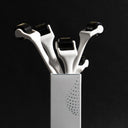If you're struggling with a receding hairline or want a different shape, you've come across the terms ' hairline lowering' and 'hair transplant' in your research.
But how do you decide which is right for you?
Each method boasts unique advantages and drawbacks, making the decision process more complex than you imagine.
In this comprehensive guide, we'll delve deep into the nuances of hairline lowering versus hair transplant, empowering you with the information you need to make an informed decision about your hair restoration journey.
Discover the intricacies of these two popular procedures, from pros and cons to effectiveness, so you can feel confident in your choice and step forward into a future with a fuller, more attractive hairline.
Let's dive into the world of hairline transformations as we pit hairline lowering against hair transplantation and help you decide which procedure could be your perfect match.
[[textbox]]
Table of content
Summary
Navigating the world of hair restoration procedures can be challenging, but understanding your options clearly is the first step towards making the right decision.
Whether you're contemplating a hairline-lowering surgery or a hair transplant, it's crucial to consider your unique needs, expectations, and circumstances.
Each procedure offers its benefits, and the best choice largely depends on your individual hair characteristics, the extent of hair loss, your desired results, and expert advice.
Remember, it's not just about restoring your hair but also about restoring your confidence.
Consult a qualified healthcare professional to explore these options further and embark on your journey towards a more fulfilling, secure, and hair-full future.
[[textbox]]
As your leading source for hair health information over the past 4 years, we never compromise on accuracy. When it comes to your health, you deserve information you can truly rely on - and earning your trust is our top priority.
Here's how Scandinavian Biolabs ensures every piece of content meets the highest standards of accuracy and integrity:
- Credentialed Experts: Our reviewers are actively practicing doctors and medical researchers
- Stringent Reviews: Content undergoes rigorous editing by subject specialists and review by a practicing doctor.
- Evidence-Based: We rely on well-established research from trusted scientific sources like peer-reviewed journals and health authorities.
- Full Transparency: Our editorial standards, writer credentials, reviewer credentials, correction process, and funding are all publicly documented.
- Independent Voice: While we do promote products, we operate in a vacuum to business operations. Our main goal is just an unwavering commitment to providing medically-sound guidance.
You can count on Scandinavian Biolabs to consistently deliver the trustworthy health information you deserve. Read our Editorial Standards.
What is a hairline-lowering surgery?

Hairline lowering surgery, also known as forehead reduction or scalp advancement, is a cosmetic procedure that aims to shorten the forehead, bring down the hairline, or change the hairline's shape. It's typically performed under general anaesthesia and involves removing a section of the forehead skin and pulling down the scalp to create a more desirable hairline.
This procedure is often favoured by those who feel their forehead is too large or their hairline too high.
It's popular among men and women but is particularly beneficial for women with a naturally high hairline.
However, a critical factor for eligibility is having enough scalp flexibility to enable the downward movement of the hairline.
The surgery generally takes 1 to 2 hours, and recovery time varies but can be around 1 to 2 weeks.
It's worth noting that, like all surgeries, hairline lowering comes with potential risks and complications, including scarring, numbness, and changes in scalp sensation.
What is the procedure for hairline lowering surgery?
Hairline lowering surgery, also known as forehead reduction or scalp advancement surgery, is a procedure where a section of forehead skin is removed, and the scalp is advanced forward and downward to reduce the size of the forehead and lower the hairline.
It involves the following steps: administration of general anaesthesia, a trichophytic incision along the existing hairline, removal of a portion of the forehead skin, repositioning the scalp, and closure of the incision with sutures.
What is the cost of hairline-lowering surgery?
The cost of hairline lowering surgery varies based on several factors, including the surgeon's expertise, geographical location, and the complexity of the procedure. On average, it can range from $7,000 to $15,000.
Please note that these are estimated costs, and the actual expense may be higher or lower.
It's also important to note that this cost typically does not include additional fees such as anaesthesia or operating room facilities.
Always consult your chosen healthcare provider for a detailed breakdown of the costs.
What is a hair transplant surgery?

Hair transplant surgery is a cosmetic procedure where hair follicles are moved from one part of the body, typically the back or sides of the head, to a bald or thinning area. The primary techniques used are Follicular Unit Transplantation (FUT) and Follicular Unit Extraction (FUE).
A hair transplant begins with the surgeon extracting healthy hair follicles from a donor area, typically the back or sides of the head, where hair is more resistant to thinning.
In FUT, a strip of the scalp is removed and dissected into individual follicular units. In FUE, individual follicles are extracted directly from the scalp.
These follicular units are then implanted into the bald or thinning area, called the recipient site, following a pattern mimicking natural hair growth. This procedure is often performed under local anaesthesia.
A hair transplant aims to provide a long-term solution to hair loss by restoring the hairline and filling in areas of thinning.
This method can yield very natural-looking results. However, it's essential to have realistic expectations, as marks can take up to a year to fully manifest, and multiple sessions may be required.
As with any surgery, hair transplants have potential risks and complications, including infection, scarring, and uneven hair growth.
What is the procedure for hair transplant surgery?
Hair transplant surgery involves moving hair follicles from a donor area (typically the back or sides of the head) to a bald or thinning area.
The main steps are local anaesthesia administration, extraction of hair follicles using either the Follicular Unit Transplantation (FUT) or Follicular Unit Extraction (FUE) methods, preparation of the recipient site, and implantation of the hair follicles into the thinning area. The process aims to create a natural-looking hair growth pattern.
What is the cost of hairline-lowering surgery?
The cost of hairline-lowering surgery typically falls between $7,000 and $15,000. However, the total cost can vary widely based on factors like the surgeon's expertise, geographical location, and the complexity of the procedure.
It's important to remember that these estimates usually do not include additional costs for anaesthesia, operating room facilities, or other related expenses.
For an accurate cost assessment, consultation with a healthcare provider is recommended.
A non-invasive and effective alternative to hairline lowering and hair transplant surgery

The Bio-Pilixin® Serum by Scandinavian Biolabs is a serum formulated to nourish hair follicles and support a healthier scalp.
Uniquely designed with multiple plant growth factors cultivated through advanced stem cell technology, this serum nourishes hair follicles and promotes healthy hair growth at the root.
Clinical studies have shown that users noticed changes in as little as 45 days when using this serum.
In a clinical study, 93% of users who tried Bio-Pilixin® Serum reported they were satisfied with the results.
This plant-powered serum is safe for daily use and designed to give your hair the care and stimulation it needs to thrive.
Every ingredient in the serum is of the highest quality, carefully selected based on a thorough review of scientific literature.
Capilia Longa, a nutrient-rich medium derived from Curcuma longa stem cells, showed in clinical studies a reduction in hair loss for some participants by up to 89–90% and an improvement in hair density by 52%.
Niacinamide is included in the formulation to support blood flow to the scalp and protect hair follicles.
The blend of ingredients in Bio-Pilixin® Serum is designed to offer a supportive environment for hair health
We are committed to customer satisfaction, offering a money-back guarantee after 150 days of using Bio-Pilixin® Serum.
What is the difference between hairline lowering and hair transplant surgery?

Hairline lowering and hair transplant surgeries are two distinct procedures with the common goal of addressing hairline and hair loss issues. While both are designed to enhance the hairline, the techniques, methods, and ideal candidates vary significantly.
Method of procedure
Hairline-lowering surgery involves reducing the size of the forehead by removing a portion of it and advancing the scalp to a lower position.
On the other hand, a hair transplant involves extracting hair follicles from a donor area and implanting them into thinning or balding areas.
Ideal candidates
Hairline lowering is often ideal for individuals with a high forehead or receding hairline but with sufficient hair density.
Hair transplant surgery suits individuals experiencing significant hair loss or thinning.
Recovery time
The recovery time for hairline lowering surgery typically ranges from one to two weeks.
Conversely, hair transplant surgery may require more healing time due to the extraction and implantation of individual hair follicles.
Long-term results
Both procedures offer long-term solutions, but they address different issues. Hairline lowering provides a more immediate result in lowering the hairline or reducing forehead size.
At the same time, hair transplants address balding or thinning areas and may take several months to a year to show full results.
Cost
Hairline-lowering surgery can range from $7,000 to $15,000, while hair transplant costs vary based on the number of grafts needed and can range from $4,000 to $15,000 or more.
Hairline lowering vs hair transplant surgery: Which one is right for you?
Hairline lowering is ideal for individuals with a high forehead or receding hairline and sufficient hair density, offering immediate results in reducing the hairline. In contrast, a hair transplant is more suitable for those experiencing significant hair loss or thinning, with results gradually appearing over several months.
Consulting with a qualified healthcare professional can help determine the most appropriate option for your situation.
Conclusion
Navigating the world of hair restoration procedures can be challenging, but understanding your options clearly is the first step towards making the right decision.
Whether you're contemplating a hairline-lowering surgery or a hair transplant, it's crucial to consider your unique needs, expectations, and circumstances.
Each procedure offers its benefits, and the best choice largely depends on your individual hair characteristics, the extent of hair loss, your desired results, and expert advice.
Remember, it's not just about restoring your hair but also about restoring your confidence.
Consult a qualified healthcare professional to explore these options further and embark on your journey towards a more fulfilling, secure, and hair-full future.
FAQs
What are the potential risks and complications of hairline lowering surgery and hair transplant surgery?
Both surgeries carry the usual risks of any surgical procedure, including infection, bleeding, and adverse anaesthesia reactions. Specifically, there could be visible scarring, changes in scalp sensation, and asymmetry for hairline lowering surgery. For hair transplants, risks include scarring, uneven hair growth, and the transplanted hair not looking as natural or dense as desired.
How long does it take to see results after a hair transplant surgery?
After a hair transplant, patients typically start seeing new hair growth after three to four months. However, the most significant and noticeable results often are visible eight months to a year post-surgery.
Who are ideal candidates for hairline lowering surgery, and who should consider hair transplant surgery?
Hairline lowering is best for individuals with a high forehead or receding hairline but with sufficient hair density. On the other hand, hair transplant surgery is more suitable for individuals experiencing significant hair loss or thinning.
Can hairline lowering surgery and hair transplant surgery be combined?
Sometimes, hairline lowering and hair transplant surgeries can be combined for a comprehensive solution, especially in patients with a high forehead and thinning hair. This integrated approach is often used to create the most natural-looking results. However, this should be discussed with a qualified healthcare professional.
How should I prepare for hairline lowering or hair transplant surgery?
Preparation for both procedures may include stopping certain medications, avoiding smoking and alcohol, and ensuring good scalp health. Specific instructions will be given by your healthcare provider based on your health history and the chosen procedure.
Resources:
- https://www.webmd.com/beauty/ss/slideshow-foods-healthy-hair
- https://www.hairscientists.org/hair-and-scalp-conditions/nutrition-and-hair-health
- https://nyulangone.org/news/most-men-experience-hair-loss-it-isnt-inevitable
Read more:






